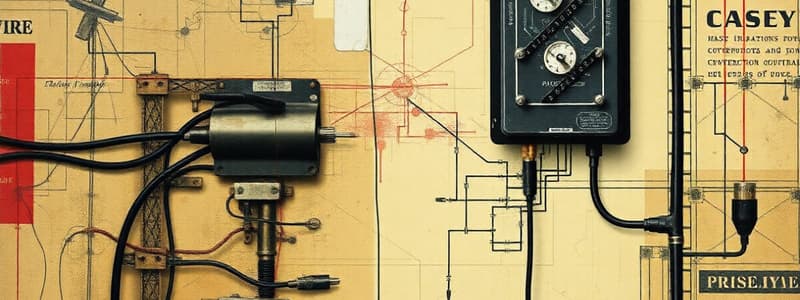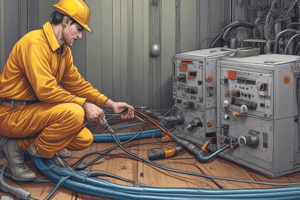Podcast
Questions and Answers
What is the primary purpose of a voltage stabilizer?
What is the primary purpose of a voltage stabilizer?
- To maintain a stable output voltage (correct)
- To increase voltage levels
- To automate the control of electrical systems
- To measure electrical consumption
Which property of cables is most critical for ensuring safety in high-temperature environments?
Which property of cables is most critical for ensuring safety in high-temperature environments?
- Current carrying capacity
- Flexibility
- Fire resistance (correct)
- Cost-effectiveness
What factor is NOT essential when selecting cables for specific applications?
What factor is NOT essential when selecting cables for specific applications?
- Conductor size
- Current carrying capacity
- Voltage rating
- Color of the insulation (correct)
What characteristic makes copper conductors preferable over aluminum in most applications?
What characteristic makes copper conductors preferable over aluminum in most applications?
Which type of insulation material is best suited for environments with frequent bending?
Which type of insulation material is best suited for environments with frequent bending?
What is the primary purpose of insulation in electrical wiring?
What is the primary purpose of insulation in electrical wiring?
Which component serves as a central distribution point for incoming power in an LT system?
Which component serves as a central distribution point for incoming power in an LT system?
What type of switch is specifically designed to disconnect a circuit for maintenance or safety?
What type of switch is specifically designed to disconnect a circuit for maintenance or safety?
Which of the following circuit protection devices automatically trips in case of overcurrent?
Which of the following circuit protection devices automatically trips in case of overcurrent?
What is the purpose of earth electrodes in an earthing system?
What is the purpose of earth electrodes in an earthing system?
Which conductor type is most suitable for applications subject to movement or vibration?
Which conductor type is most suitable for applications subject to movement or vibration?
What feature should be considered for wires that will be exposed to outdoor conditions?
What feature should be considered for wires that will be exposed to outdoor conditions?
Which configuration would a Normally Open (NO) switch have when at rest?
Which configuration would a Normally Open (NO) switch have when at rest?
What is the primary purpose of a distribution box in an electrical system?
What is the primary purpose of a distribution box in an electrical system?
Which factor is crucial when selecting a switch for handling a specific electrical load?
Which factor is crucial when selecting a switch for handling a specific electrical load?
What should be considered when selecting a distribution box for current demand?
What should be considered when selecting a distribution box for current demand?
Which type of metering system is best for real-time power measurements?
Which type of metering system is best for real-time power measurements?
Which enclosure type is most suitable for industrial applications?
Which enclosure type is most suitable for industrial applications?
What defines Time-of-Use (TOU) rates in electricity pricing?
What defines Time-of-Use (TOU) rates in electricity pricing?
What is a primary consideration in evaluating a metering system's accuracy?
What is a primary consideration in evaluating a metering system's accuracy?
What is the primary purpose of a fuse in an electrical circuit?
What is the primary purpose of a fuse in an electrical circuit?
Which characteristic defines a fast-blow fuse?
Which characteristic defines a fast-blow fuse?
What disadvantage is associated with fuses?
What disadvantage is associated with fuses?
What does the breaking capacity of a fuse indicate?
What does the breaking capacity of a fuse indicate?
What is the role of the fuse holder in an electrical system?
What is the role of the fuse holder in an electrical system?
What type of trip mechanism does a Miniature Circuit Breaker (MCB) use to respond to sustained over currents?
What type of trip mechanism does a Miniature Circuit Breaker (MCB) use to respond to sustained over currents?
Which voltage rating is NOT commonly associated with MCBs?
Which voltage rating is NOT commonly associated with MCBs?
What feature do some MCBs have that indicates the breaker has reached the end of its operational life?
What feature do some MCBs have that indicates the breaker has reached the end of its operational life?
What is the primary function of the arc chute in a Miniature Circuit Breaker (MCB)?
What is the primary function of the arc chute in a Miniature Circuit Breaker (MCB)?
Which statement correctly describes the breaking capacity of an MCCB?
Which statement correctly describes the breaking capacity of an MCCB?
What is the primary purpose of an ELCB?
What is the primary purpose of an ELCB?
Which type of ELCB operates by sensing an imbalance in current flowing through the live conductor?
Which type of ELCB operates by sensing an imbalance in current flowing through the live conductor?
What feature of ELCBs ensures quick detection and disconnection of leakage current?
What feature of ELCBs ensures quick detection and disconnection of leakage current?
How do inverse time characteristics influence tripping time of protective devices?
How do inverse time characteristics influence tripping time of protective devices?
What is indicated by the steepness of the slope on an inverse time characteristic curve?
What is indicated by the steepness of the slope on an inverse time characteristic curve?
What is the main function of a contactor in an electrical system?
What is the main function of a contactor in an electrical system?
Which component of a contactor generates a magnetic field when energized?
Which component of a contactor generates a magnetic field when energized?
What distinguishes an isolator from a contactor?
What distinguishes an isolator from a contactor?
Which feature is included in some isolators to enhance operational safety during maintenance?
Which feature is included in some isolators to enhance operational safety during maintenance?
Which characteristic of contactors is essential for protecting against excessive current?
Which characteristic of contactors is essential for protecting against excessive current?
Flashcards
LT System Components
LT System Components
Electrical wiring components designed for lower voltage levels; includes conductors, insulation, sheath, distribution boards, switches, circuit breakers, relays, fuses, contactors, busbars, earthing components, and lighting fixtures.
Distribution Boards (DB)
Distribution Boards (DB)
Electrical panels that distribute power to various circuits or areas within a building; include MDB and Sub-DB.
Circuit Breakers (MCBs/MCCBs)
Circuit Breakers (MCBs/MCCBs)
Automatic switches that trip to protect circuits from overcurrent or short circuits; MCBs are small/low current, MCCBs are for higher currents.
Contactors
Contactors
Signup and view all the flashcards
Earthing System
Earthing System
Signup and view all the flashcards
Voltage Rating of Cables
Voltage Rating of Cables
Signup and view all the flashcards
Current Carrying Capacity
Current Carrying Capacity
Signup and view all the flashcards
Conductor Material (Cables)
Conductor Material (Cables)
Signup and view all the flashcards
Insulation Material (Cables)
Insulation Material (Cables)
Signup and view all the flashcards
Wire Gauge (AWG)
Wire Gauge (AWG)
Signup and view all the flashcards
Wire Selection Factors
Wire Selection Factors
Signup and view all the flashcards
Switch Types
Switch Types
Signup and view all the flashcards
Switch Current Rating
Switch Current Rating
Signup and view all the flashcards
Distribution Box Types
Distribution Box Types
Signup and view all the flashcards
Environmental Factors (Wiring)
Environmental Factors (Wiring)
Signup and view all the flashcards
Ratchet Charges
Ratchet Charges
Signup and view all the flashcards
Fuel Adjustment
Fuel Adjustment
Signup and view all the flashcards
Renewable Energy Premium
Renewable Energy Premium
Signup and view all the flashcards
Fuse Function
Fuse Function
Signup and view all the flashcards
Fuse Element
Fuse Element
Signup and view all the flashcards
Current Rating of a Distribution Box
Current Rating of a Distribution Box
Signup and view all the flashcards
MCB Trip Mechanism
MCB Trip Mechanism
Signup and view all the flashcards
MCB Trip Curve 'B'
MCB Trip Curve 'B'
Signup and view all the flashcards
Metering System
Metering System
Signup and view all the flashcards
Time-of-Use (TOU) Rates
Time-of-Use (TOU) Rates
Signup and view all the flashcards
MCCB Current Rating
MCCB Current Rating
Signup and view all the flashcards
MCB Breaking Capacity
MCB Breaking Capacity
Signup and view all the flashcards
Demand Charges
Demand Charges
Signup and view all the flashcards
MCCB Adjustable Settings
MCCB Adjustable Settings
Signup and view all the flashcards
Enclosure IP Rating
Enclosure IP Rating
Signup and view all the flashcards
Arc Chute
Arc Chute
Signup and view all the flashcards
ELCB (Earth Leakage Circuit Breaker)
ELCB (Earth Leakage Circuit Breaker)
Signup and view all the flashcards
Inverse Time Characteristic
Inverse Time Characteristic
Signup and view all the flashcards
Rated Current (ELCB)
Rated Current (ELCB)
Signup and view all the flashcards
Tripping Time (ELCB)
Tripping Time (ELCB)
Signup and view all the flashcards
Single Line Diagram
Single Line Diagram
Signup and view all the flashcards
Contactor
Contactor
Signup and view all the flashcards
Contactor Coil
Contactor Coil
Signup and view all the flashcards
Isolator
Isolator
Signup and view all the flashcards
Isolator Contacts
Isolator Contacts
Signup and view all the flashcards



